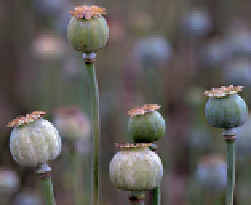Agriculture Reference
In-Depth Information
Poppyseeds are ripe when they rattle inside the seed capsule.
HARVEST
Capsules are ready for harvest when the entire plant is brown and seeds rattle in the capsules
when shaken. Beware of birds at this point, as they love to snack on ripe poppyseeds, to the point of
clearing out small patches entirely by causing capsules to fall to the ground and breaking them open.
SELECTION CHARACTERISTICS
Poppy is enjoying a resurgence in popularity in central Europe, with
many new field introductions. Possible selection criteria for home gardeners:
• yield (amount of seed per capsule, number of capsules per plant)
• flower color (mark plants with flower of desired color with tape)
• tendency to produce side shoots
• shape and size of capsules
• flavor
• oil content of seeds
• color of seeds
DISEASES AND PESTS
The main challenge in growing poppies are weeds, which can crowd out slow-
growing young plants. Weed regularly. Downy mildew (
Peronospora
spp.) and parasitic leaf diseases
can affect patches that were sown too densely or too late. When seed is sown early enough, plants have
been thinned, and weeding is done often enough, these diseases do not cause any major problems. If
birds are a problem, try covering the patch in bird netting.
CULTIVATION HISTORY
The opium poppy is one of Europe's oldest crop plants, one of the few from
the Neolithic period that is not from the Middle East (where it did not arrive until the Bronze Age). It
is presumed to have been domesticated in the western Mediterranean region. The oldest finds, from
Poland to Germany, Switzerland, northern France, northern Italy, and southern Spain, date from the
Stone Age (4600-3800
BC
).
Worldwide production of opium poppy has been sharply reduced because of the possibility of pro-
ducing the drug opium from some varieties.

